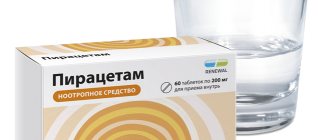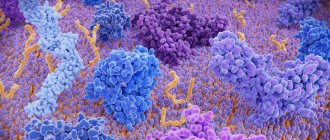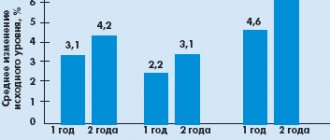About the drug
Bifidumbacterin is a probiotic intended to normalize intestinal microflora.
The main component of Bifidumbacterin is active live bacteria, normally contained in the intestinal microflora of a healthy person in the amount of 107 per dose.
In addition to them, the drug contains a bifidogenic factor that promotes the growth of beneficial bacteria, and the disaccharide lactose. Expected results from taking the drug:
- activation of gastrointestinal tract functions;
- stimulation of metabolic processes;
- increase in the body’s nonspecific resistance to negative factors;
- accumulation of toxins;
- immunomodulation of the body;
- preventive action against dysbacteriosis after radiation therapy, chemotherapy, treatment with antibiotics and hormones;
- normalization of the digestive process.
The effect of the drug extends to a large number of representatives of pathogenic flora:
- staphylococci;
- Proteus;
- shigella;
- enteropathogenic Escherichia coli;
- yeast-like fungi.
After taking the drug, the intestines are populated with bifidobacteria, which begin the process of normalizing the flora and regenerating the mucous membrane, detoxifying the body.
Bifidumbacterin for children
The medicine can be given to babies from birth. It is prohibited to give suppositories to children under 3 years of age. If you follow the regimen developed by your doctor, you can achieve maximum effectiveness from taking it.
Bifidumbacterin is usually given to infants suffering from colic and to eliminate dysbiosis. The instructions say that the medicine can be given to babies born by cesarean section or born prematurely if an infection develops in the intestines.
Depending on the severity of the disease, the duration of the treatment course can range from several days to several weeks (sometimes months). The medicine should be given on an empty stomach, half an hour before meals, or an hour after.
Many parents are interested in the question of whether it is possible to add medicine to the mixture. Pediatricians assure that such a technique is acceptable, but the result may not be so pronounced.
Who should use a probiotic?
Bifidumbacterin is used to treat hepatitis and pancreatitis.
The high therapeutic activity of Bifidumbacterin is used for the following conditions and diseases:
- dysbiosis of the gastrointestinal tract - treatment and prevention of ulcerative lesions of the gastrointestinal tract, hepatitis, pancreatitis, treatment with antibiotics, hormonal and non-steroidal anti-inflammatory drugs;
- infections caused by pathogenic microflora;
- disturbances in the process of defecation after long-term treatment with microflora antagonists - antibiotics (constipation or diarrhea);
- food poisoning;
- malsorption syndrome;
- pre- and postoperative normalization of the biocenosis of the gastrointestinal tract;
- prevention of hospital infections.
The drug can be used topically, as well as rectally or intravaginally in the following cases:
- urogenital infections;
- urogenital dysbacteriosis;
- gardnerellosis;
- colpitis of various etiologies, including senile;
- vaginal dysbiosis of pregnant women - prevention before childbirth;
- preoperative prevention of vaginal infections;
- prevention of mastitis during lactation.
A wide range of indications for taking the drug, its effectiveness and low cost contribute to the high popularity of Bifidumbacterin.
When accepted
Bifidumbacterin should be taken for the following diseases and problems:
- dysbacteriosis;
- acute intestinal infection;
- chronic inflammatory processes in the intestines;
- transfer of infants to artificial formula.
Can be used in complex therapy for the treatment of sepsis and pneumonia in children. It is also used for the purpose of sanitizing the female genital organs by women who are preparing to give birth. Elderly women are often prescribed for inflammation of the vaginal mucosa.
The product is effective for preventive purposes for women during lactation.
Features of application
Before taking probiotics, you should consult a gastroenterologist.
Before taking a probiotic, you should consult a doctor (pediatrician, therapist, gastroenterologist, surgeon) and read the instructions for use.
Self-medication and self-diagnosis are unacceptable, especially when treating children and elderly patients with Bifidumbacterin. Methods of using the drug:
- oral,
- rectal,
- intravaginal.
Oral administration requires diluting the product in a liquid medium: a small amount of boiled water, liquid food. Newborns and infants are given the drug during feeding; it is diluted in breast milk or infant formula.
There is no need to completely dissolve Bifidumbacterin; the solution with bacteria should be drunk immediately. It is advisable to take the probiotic with food, but strict adherence to this condition is not at all necessary. Recommended doses of the drug:
- Preparation for gastrointestinal surgery and prevention of postoperative complications - from 15 to 30 doses daily, they should be taken 3-5 days before. before surgery, and for 1.5-2 weeks. after her.
- Intestinal infections, inflammatory diseases - from 25 to 50 doses daily, take 1.5-2 weeks. In addition to this method of treatment, you can use 1-2 rectal suppositories three times a day. If the intestinal infection has become chronic, treatment is extended until complete recovery (on average, 3-4 weeks).
- Prevention of gynecological vaginal infections, restoration of a high degree of purity of vaginal secretions before childbirth, for the prevention of complications after operations on the pelvic organs - 2 suppositories per day, course - 5-10 days.
- For irrigation of the vaginal mucosa, preparation of vaginal baths, applications for the prevention of mastitis, for urogenital dysbacteriosis, a lyophilisate solution is prepared from 5-10 doses of the drug per 1 tbsp. l. boiled water, a tampon for local use is moistened in it, the course of treatment is until the symptoms of the disease disappear, on average - 8-10 days.
To treat intestinal dysbiosis, the drug in powder form in sachets is used during the day in the following doses:
- adults – 2 packets 3-6 times;
- patients over 7 years old - 2 packages 3-4 rubles;
- from 3 to 7 years – 1 package 3-5 rubles;
- from 6 months up to 3 years – 1 package 3-4 rubles;
- from birth to 6 months. – 1 package 2-3 r.
A course of taking a probiotic, taking from 3 to 5 weeks, is prescribed by the attending physician. If necessary, courses are repeated several times after a month's break between them.
Bifidumbacterin lyophilisate for oral and local use 5DOZ bottle No. 10
Contraindications
Individual intolerance.
Directions for use and doses
Bifidumbacterin is used orally for intestinal diseases, and in obstetric and gynecological practice: locally (intravaginally).
1. Treatment and prevention of gastrointestinal diseases:
Dissolve the contents of the bottle with boiled water at room temperature at the rate of 5 ml (teaspoon) of water per 1 dose of the drug.
Dissolution is carried out as follows: pour the required amount of water into a glass (in accordance with the number of doses indicated on the bottle); open the bottle by removing the cap and stopper; transfer a small amount of water from the glass into the bottle; after dissolution (the drug dissolves in no more than 5 minutes to form an opaque homogeneous suspension), transfer the contents of the bottle into the same glass and mix. One teaspoon of the drug dissolved in this way is 1 dose. The dissolved drug cannot be stored.
Take the required number of doses (respectively, teaspoons) 20-30 minutes before meals or 1-1.5 hours after meals. The drug can be given to infants immediately before feeding.
For intestinal diseases: for children in the first half of life, the drug is prescribed 5 doses per dose 2 times a day, for children in the second half of the year and older - 5 doses 3 times a day.
For newborns at risk, it is advisable to start using the drug in the maternity ward from the first day of life until discharge, 2.5 doses per dose 2 times a day.
Children with sepsis, pneumonia and other purulent-infectious diseases are prescribed 5 doses 3 times a day in combination with generally accepted methods of treating the underlying disease. If gastrointestinal dysfunction and the threat of ulcerative necrotizing enterocolitis occur in this group of children, the dosage of bifidumbacterin is increased to 20 doses per day.
For acute and chronic inflammatory diseases of the small and large intestines, children over 3 years of age and adults are recommended to take 5 doses 2-3 times a day. In severe cases of the disease, the dose may be doubled.
The duration of treatment with bifidumbacterin is determined by the severity of clinical manifestations, the age of the patient and is 2-4 weeks, and in some cases - up to 3 months.
For prophylactic purposes, the drug is prescribed 5 doses 1-2 times a day for 1-2 weeks.
2. In obstetric and gynecological practice:
To treat the area of the nipple and areola of postpartum women, the contents of one bottle (5 doses) are dissolved in a small amount of chilled boiled water, soaked in the solution of 2 sterile tampons, which are applied to the nipple and areola for 20-30 minutes before each feeding for 5 days. A tampon soaked in the drug is left on the surface of the mammary gland until feeding begins.
For inflammatory diseases of the female genitalia and prenatal preparation of pregnant women at risk, bifidumbacterin is prescribed 5-10 doses once a day for 5-8 days under the control of restoration of the purity of vaginal secretions to grade I-II and the disappearance of clinical symptoms of the disease.
For intravaginal administration, bifidumbacterin is also dissolved in the above manner. The resulting suspension of the drug is impregnated with a sterile tampon, which is inserted intravaginally without squeezing and left for 2-3 hours.
If necessary, the course of treatment with bifidumbacterin can be repeated.
Storage conditions
The drug is stored in accordance with SP 3.3.2. 1248-03, at a temperature not exceeding 10°C, out of the reach of children.
Transportation conditions:
Transportation is carried out in accordance with SP 3.3.2. 1248-03, at a temperature not exceeding 10°C.
Not suitable for use:
- upon expiration of the expiration date, or stored in non-compliance with regulated conditions;
Best before date
2 years.
special instructions
The simultaneous use of oral forms with antibiotics, as well as dissolving the drug in hot water (above 40°C) and storing it in dissolved form is not recommended.
Description
A drug that regulates the balance of intestinal microflora (probiotic).
Dosage form
Crystalline or porous mass with possible stratification of biomass in the upper part, beige or whitish-gray in color, with a specific odor.
Use in children
In children (including premature infants) it can be used from the first days of life in dosage forms intended for this category of patients in accordance with age.
Pharmacodynamics
Live bifidobacteria have high antagonistic activity against a wide range of pathogenic and opportunistic intestinal microorganisms (including staphylococci, Proteus, enteropathogenic Escherichia coli, Shigella, some yeast-like fungi), restore the balance of intestinal and vaginal microflora, normalize the digestive and protective functions of the intestine, and activate metabolic processes , increase the nonspecific resistance of the body.
Side effects
Possible: allergic reactions, nausea.
Use during pregnancy and breastfeeding
Can be used during pregnancy and breastfeeding according to indications in appropriate dosage forms.
Interaction
When taken simultaneously with chemo- and antibacterial drugs, a decrease in therapeutic effectiveness may occur.
The effect of drugs containing bifidobacterium bifidum is enhanced by vitamins (especially group B).
Impact on the ability to drive vehicles and operate machinery
The drug does not affect the performance of activities requiring special attention and quick reactions (driving vehicles, machinery, etc.).
Contraindications and side effects
Bifidumbacterin has no side effects.
The drug does not have any significant contraindications other than individual intolerance. It is not recommended to use the product in the treatment of children with lactase intolerance, which is part of Bifidumbacterin.
Pregnant and lactating women can take the probiotic without restrictions, since its components do not penetrate into the blood through the intestinal walls. The only side effect of the drug is an allergic reaction to its components.
Interaction with other drugs
Bifidumbacterin does not cause undesirable effects when interacting with all pharmaceutical groups. It can be part of complex therapy along with antibacterial drugs.
The activity of the drug increases if it is taken simultaneously with B vitamins, and decreases when used during antibiotic treatment. Under incorrect storage conditions and after a year from the date of manufacture, the bacteria contained in the probiotic lose their viability.
Bifidumbacterin should be stored in a cool place at a temperature not exceeding +5? C. Manufacturers of the drug allow the possibility of its short-term storage (no more than 10 days) at room temperature.
Indications for use
The medicine is indicated for patients with the following diseases and conditions of the body:
- dysbacteriosis;
- acute intestinal infections;
- chronic inflammation of the small and large intestines;
- intestinal dysfunction associated with the development of dysbiosis;
- long-term intestinal dysfunction;
- transfer to artificial feeding of children in early infancy.
As part of a complex treatment, the drug is used in the treatment of children suffering from pneumonia and sepsis . It is used to sanitize the genital tract in women, to prepare for childbirth in women who have grade III-IV disturbances in the purity of vaginal secretions, and for senile colpitis (inflammation of the vaginal mucosa in older women). The medicine is also used to provide prevention of mastitis in women who are breastfeeding.


